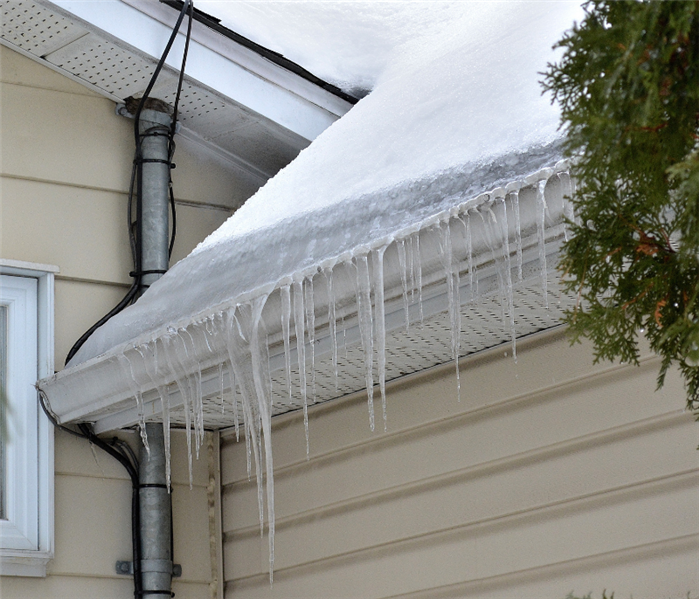What Damages Do Ice Dams Cause?
12/2/2020 (Permalink)
 What may seem like a large icicle on your roof may actually be an ice dam causing damage to your home.
What may seem like a large icicle on your roof may actually be an ice dam causing damage to your home.
After a winter storm, excess snow and ice on your roof can cause considerable damage to your home through the formation of ice dams.
These form when warm temperatures in your attic cause snow on the roof to melt. This melted snow runs down the slope of the roof, but then refreezes at the eaves due to their cooler temperatures. When this cycle repeats, the frozen snowmelt forms a large block of ice at the edge of your roof, called an ice dam.
Just what kind of damages can these cause to your home? Can ice dams damage shingles, cause leaks, or threaten the integrity of your roof? The top problems caused by ice dams include:
- Roof Damage & Roof Leaks
- Water Damage
- Mold Growth
Ice Dams Cause Damage to Your Roof
These blocks of ice can cause the need for extensive roof repairs once melted away. This is due to the way they form. Once an ice dam forms on your roof, it doesn't allow additional melting snow and ice to flow off the roof. Rather, the water becomes blocked. This may cause water to seep behind the shingles of your roof. When this water refreezes, it can shift shingles, crack, or damage them.
These blocks of ice can also damage your roof by causing it to sag from the weight. This can then cause problems for your gutter system, soffit, and fascia on the roof. All of these issues together will likely cause winter roof leaks, which will spread damages around your home.
Ice Dams Cause Water Damage in Your Home
If you've ever wondered if snow was causing a roof leak - you were on the right track. When melted snow forms into ice dams, the damage they cause to your roof will cause water to leak into your home.
These leaks can cause widespread water damage depending on when they are caught and remedied. You may notice water stains on ceilings, peeling paint, water in light fixtures, drooping ceilings, soft walls, or actively flowing water due to ice dams.
What you may not see is the wet insulation and structural components of your home, as they are hidden behind walls. It's important to take action any time you notice visible sings of water damage to resolve the problem before it causes even more extensive damages.
Ice Dams Can Cause Mold in Your Home
It may not be the first thing that comes to mind, but the roof leaks from ice dams can cause mold and mildew to grow in your home. This is because mold thrives on moisture, especially when an environments is continually moist. When you couple this with warm temperatures inside your home, it's the perfect recipe for mold to grow.
Mold growth can be widespread or contained depending on the extent of water damage cause by your ice dam. There's a saying, "Where there is water damage, there is mold!" and this holds true unless water leaks are dealt with promptly.
How Can You Prevent Damage From Ice Dams?
When winter weather comes around, you should take steps to prevent ice dams. That's because it's essentially the only way to prevent your home sustaining damage from them. Take the following steps to help prevent the formation of ice dams on your roof this winter:
- Properly ventilate your attic so that it stays cool and doesn't melt the snow on your roof.
- Make sure that any exhaust fans are discharged outside, rather than in the attic to keep it cool.
- If possible, minimize the amount of recessed lighting directly under your attic to prevent warming it.
- Purchase a roof rake to clear your roof after a snow storm so ice dams don't have a chance to form.
- Clean your gutters every fall so that melting snow can more easily drain away.
- Don't use calcium chloride to melt ice on your roof, as it can corrode gutters, shingles, or downspouts.
Related Articles:
Preparing For A Blizzard This Winter



 24/7 Emergency Service
24/7 Emergency Service